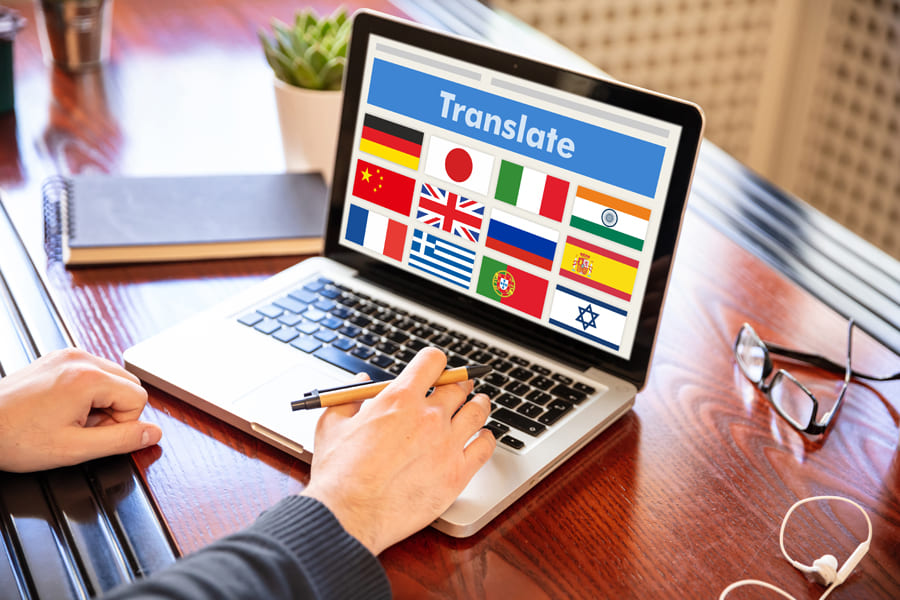If you’re setting out in e-commerce or already have a site up and running, you may be keen to branch out to international markets. This is where a multi-language website comes into its own.
Having your site available in a number of different languages can open up a wealth of new opportunities and markets. In fact, a single-language website is becoming a thing of the past.
You may already be wondering what you need to do to create a site that operates in multiple languages.
We’ve written this article especially for you — so you know what to do to make your site accessible in more than one language and convert visitors from around the world.
We’ll cover how to deal with issues such as website translation, search engines for multiple languages, and localization. This means you can create an e-commerce site that welcomes visitors in their native language so you can win more customers and generate greater profits.

What is a multi-language website?
A multi-language website is a site that offers content in more than one language. This type of site will often offer a language selection menu from which the visitor can choose their preferred language.
Sometimes, you may come across a multilingual website that displays two languages or more on a single page, although the first from our multi-language website examples is more common.
Creating a multi-language website
Multi-language sites have many advantages for anyone selling their goods or services online. You can reach more audiences and make deeper connections with your customer base by enabling them to access your site in their chosen language.
If you think multilingual content could benefit your site, continue reading to find out more about the steps you need to take.
Choose a content management system (CMS)
The first thing you’ll need to do is choose your content management system.
Content management systems refer to the software that lets you create a website from scratch and then manage and change it without having to know anything about code or the “technical bits.” They’re simple ways to build your own website with intuitive steps that make the process easy.
Your CMS platform will enable you to create a website in your original or primary language. Only once you’ve fulfilled this step can you go on to offer its content in a new language or languages.
Create a website structure that supports multiple languages
Of course, you will need to choose a structure that is actually going to support multiple languages.
A self-hosted content management system is often a good option for multi-language websites.
You can look for one that gives you access to translation tools like Google Translate to automatically translate your content.
While you’re searching for the best structure for your multi-language website, make sure it supports any non-Latin scripts — for example, Arabic, Chinese, or Russian.

Translate website content
The next step is to get all your website content — text, image tags, videos, and others — translated into the languages of your choice.
If you’ve already chosen a CMS that supports an automatic translation tool, then you’re good to go. Be aware, however, that these tools can sometimes produce a literal translation that doesn’t capture all the subtleties of language.
Another option is to seek a professional translator working in your target language or languages. A native speaker will be able to translate the nuances of language and understand localization issues and cultural sensitivities, too.
Don’t forget the alt text (written descriptions of digital images) and subtitles for videos.
Adapt web design to support multiple languages
Once you have your translated content in your desired languages, you’ll most likely need to adapt the website design. This is especially true if you’re using non-Latin scripts, which may not be supported in certain font styles.
You’ll notice that the text in your chosen languages may take up more or less space than the original text, so you’ll need to adjust your layout to accommodate it. A translation tool with a visual interface is invaluable here, as it will let you preview the translated text.
It’s essential that you get the navigation right, too. Keep the navigation menu simple to start with to make it easy for visitors accessing the site in any language to find the pages they want. Don’t use more navigation items than necessary, and avoid using slang or idioms that won’t translate easily — clarity is key.
Managing a multi-language website
Once you’ve created your multi-language site, you should consider how you will manage it going forward.
To minimize your input, set up your website with tools and features that will make your fully translated website as self-managing as possible.
Creating a content management process for translations
A translation management system (or TMS) uses software that draws on AI to provide automated translations for your website content. This is the simplest way to manage the content on your websites across all the languages you offer.
It can be a quicker and more affordable alternative to using human translation, which takes time to organize and involves cost and admin.
Managing website updates and changes across all languages
The beauty of using a TMS is that it will automatically manage your website updates and make the changes you need, offering dynamic content instantly.
For example, when updating or adding product descriptions, your TMS automatically updates the text in the languages it’s programmed for, using AI and memory software.
While you’ll still need to go through and check for errors, you’ll save a lot of time and effort by not having to arrange translations individually.
Implementing search engine optimization (SEO) for each language
Multilingual SEO is another feature that’s essential to your website’s success. It’s no use translating your site if potential customers can’t find it.
Optimizing your website for all your available languages means that any user around the world can find it, no matter which search engine or language they are using.
First, you’ll need to take a look at your URL structure and create a URL for each language you’re working in.
To use the example of Ikea, their dedicated URL is ikea.com. Then, they have a number of URLs with language indicators to represent individual countries and languages. For example, the English-language site in the United States has “ikea.com/us/en” as its dedicated URL.
You’ll also need to use something called “hreflang.” This is an HTML attribute that indicates to Google which language each of your website’s pages works in. This means it can be easily searched in any of those languages.
The right keywords are also essential. Translating keywords used in an English version of your site into different languages won’t work. Instead, use top-ranking keywords in each of your chosen languages.
Finally, don’t forget your metadata (for example, title tags and meta descriptions). These must be translated into your target languages, too.
Managing user-generated content across multiple languages
User-generated content such as reviews are a vital part of the customer experience, having a significant influence on purchasing decisions.
This means your user-generated content must be available to all your site visitors in a language of their choice.
While you can add a translation under individual items of user-generated content, this can be a laborious process for the reader. Instead, use a “Translate all” feature or language filter so that visitors can automatically see the content in their preferred language or find content themselves in a particular language.
Technology solutions for creating and managing a multi-language website
Make the most of tech solutions to create and manage your multi-language website, and you’ll save a lot of time and trouble.
We’ve already touched on some of the essentials you’ll need — namely, a content management system that supports your languages and scripts and translation tools or a translation management system.
You can also make it easy for your visitors to select a language by incorporating a language switcher. This gives them the freedom to choose which language they experience your site in.
Translation management software (TMS)
As we’ve seen, translation management software is a timesaver when it comes to creating and managing multilingual websites.
In one seamless experience, it will help you manage your site in multiple languages, making it accessible to visitors from all over the world.
You can use it as a plugin tool or as part of an e-commerce platform service like NEXT BASKET to streamline your multilingual operations.
Website localization software
Translation alone isn’t enough to provide speakers of other languages with the authentic experience they’re looking for.
You will also need to localize your content for your target audience. This means adapting it for users from diverse cultures who may speak different languages.
Examples of localization include using photographs of models who reflect the heritage of the language your page is in. It also means being aware of cultural sensitivities. For example, in many Western cultures, the color green represents growth, nature, and environmental issues. However, in China, it is linked to infidelity and shame.
Showing that you understand these cultural differences means you’ll be far more likely to win over customers from all around the world.
At the same time, you’ll need to find a balance with conveying a consistent message in terms of using the same branding throughout the different versions of your site. Be clear about your brand message and brand image in the original site so it translates easily into other languages (just like the words).

Multilingual plugins and extensions for CMS platforms
Remember, if you don’t want to go all out with a translation management system, then you can include multilingual plugins and extensions to use with your chosen CMS platform.
There are lots to choose from. Popular translation plugins include TranslatePress, WordPress Multilingual Plugin (WPML), and Polylang.
If you are using automated translation services like these, just be aware that they may not necessarily produce 100% correct, idiomatic, and culturally sensitive target text. There’s nothing like the human touch to accurately transfer all the hidden nuances from one language to another.
Website translation services
One way to make your website available in multiple languages is to use a website translation service. This involves using translators who specialize in your sector to translate your entire website.
These days, translators use software to produce a first draft translation and then edit it to ensure that the text is accurate, reads well, and is localized. It’s this personal touch that can make all the difference between text that passes the grade and flawless text that reads seamlessly.
However, you may not want to coordinate the various freelance translators you’ll need to produce text in your chosen languages. Of course, you can also use the services of a translation agency to help you.
But while it’s an excellent option, it can turn out to be less affordable than using a recommended plugin.
Best practices for creating and managing a multi-language website
We share some best practices for creating and managing your multi-language website to get the most out of your site and tap into the full potential of international markets.
Choose the right languages to support
You’ll probably already have an idea of which languages you want to use on your website. Make sure that you can actually ship to the countries where they’re spoken.
If you’re not sure which languages would work, then do your research to find out which countries have the biggest markets for your product or service and make your choices based on this data.
Use clear and concise language that is culturally appropriate for each target audience
The simpler the terms you use for your default language, the easier it will be to translate.
Try to avoid flowery or idiomatic language that may be hard to convey in a different tongue. It’s also a good idea to get a native speaker to check the translated content for each language version to know that it sounds natural and flows seamlessly.
Optimize website performance for all languages
Make sure your website works equally well in each different language. Translation and localization are a large part of this, but there are other considerations, too.
For example, place your language switcher in a prominent place on your home page so they can easily flip to the language they feel most comfortable in.
Ensure consistent user experience across all languages
Test every web page for each language so you know that it looks right and works well. This is extra important if different alphabets have been used. Recruit people who speak the same language so they can test out every aspect of your website and report back any glitches.
Monitor website analytics and user feedback to make improvements
Keep track of your metrics to know how your website is doing and where it’s performing best and worst. Engage with your customers to know how the experience of visiting the site was for them.
Considerations for choosing a CMS for a multi-language website
When choosing a CMS for your multi-language website, ensure it has everything you need to help give all visitors a great experience.
CMS platform capabilities for managing multiple languages
Ensure your CMS platform has what it takes to manage not just one but two or more languages. If you’re not sure, enlist the help of an IT expert or use an online platform designed for multilingual sites.

Integration with translation management and localization software
Translation and localization are key to the success of your multi-language website. Be sure that your CMS includes and integrates both of these elements.
Cost and affordability
Check out deals with online platform services that give you a certain number of months for free or a choice of affordable options. This is ideal for e-commerce businesses just starting out on the international market.
Ease of use and user-friendliness
Test, test, and test your multi-language website again to be sure that it provides a seamless user experience.
Technical support and resources
Consider where the technical support you need to maintain your site is going to come from. If technical terms aren’t your thing, consider using an online platform provider that offers support as part of a package.
So, if you’re looking for a solution that will do the hard work for you, reach out to us at NEXT BASKET. We provide solutions for multilingual website creation, seamlessly creating a fully functional and optimized site for your global business.
Frequently asked questions
What’s the easiest way to get text for my website translated into multiple languages?
You can choose a translation plugin to automatically translate text, use human translation services, or opt for an online platform service that will take care of all the translation and localization for you.
How can I ensure my branding is consistent across all versions of my website?
Use the same templates for your web pages, whichever language your page is in. Pay attention to localization issues when considering your branding to be sure it works well in each language and associated culture you are using.
Creating a multilingual website sounds like a lot of work — how can I find help?
Creating your own multi-language website from scratch takes time and dedication. And that’s not to mention all the other aspects of your e-commerce business, like uploading your products onto the site and marketing.